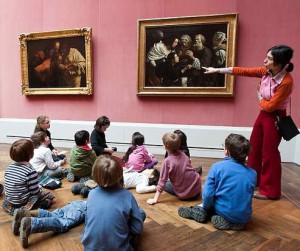 “The real beauty is perceived only by pure, perfect mind of a child”
“The real beauty is perceived only by pure, perfect mind of a child”
E.Medgelaitis
Art is an indispensable part of human life. It goes back to the ancient time. But then, our ancestors did not know that their activity in this area may bring us much good. It shows us the importance of art in every stage of human development. In human life art plays a significant role. Especially now, when the question of the development of creative personality arises.
No one can normally (sanely) exist without art, because all that surrounds us, is art. It is also important in children’s lives, as it promotes the formation of personality, morality, cultural development. It fosters awareness of moral and aesthetic qualities, nurtures creativity. When you want to introduce your child to the arts? How to do it correctly? At what age? Most parents face these questions. Some of them believe that the child is still immature and is not sensible of the importance of art. But it is not the case.
Even from an early age, parents and educators must cultivate love of art in children, introduce them with the types of art. After all, if the child is not turned to art, it has not enjoyed good music from early childhood, has not attended art institutions, in the future there is a slight chance that the child will be interested in inwardness and aesthetic side of life.
In modern education the issue of children education through art and development of creative abilities arises greatly. This issue has been studied by many teachers including L.S. Vyhotskyi, V.O. Sukhomlynskyi, Z.Freud and others.
The sources of creativity, moral and aesthetic education are works of fine art, music, cinema, theater, museums, various exhibitions, literary societies. There are also a lot of means and methods of moral and aesthetic education, such as conversation, independent artistic activity, home-life aesthetics, events and classes arrangements, works of art.
To my mind, one of the most important means of moral and aesthetic education are excursions to the art institutions. An excursion is collective trip to museums, theaters, historic sites in view of raising an awareness.
They are efficient in education as children receive information not only in words but also see it firsthand experiencing emotions; it is easier to memorize the information. As the proverb says: “It is better to see once than to hear a hundred times”.
Excursions to art institutions should be organized with preschool children, as they are more consciously perceive information they are more attentive, they memorize better and reproduce the information observed and heard. These trips can be made to museums, theaters, galleries and exhibitions. The choice is wide, but that is not the point. The main thing is the benefit these trips can bring, the effectiveness of their arrangement. Because a final result depends on manner trip is being conducted, that is the knowledge and information received by children during it.
In my opinion, such means of education as a trip to art institutions should be taken into account by the parents. As a matter of fact, aesthetic, moral, patriotic feelings, creativity are developed during this trip.
Such measures may also have a positive influence on the moral side of the personality – kids find something new, get lots of positive emotions and pleasant experiences. Thus, a love of art is cultivated in children, the ability to see beauty in daily life and creative thinking are developed. Interaction with art inspires children to new challenges, pushes them to art, invites them to create beauty.
This form of work also allows children, teachers and parents to get acquainted more closely and to cooperate. Parents will be able to know what their child is interested in and help it to make a choice in this area in time.
Typically, these kinds of trips should not be involuntary. They should be counducted in order to introduce, clarify and provoke interest to art in children. Children should understand the importance of the trip, as it affects the outcome of the work.
The role of trips to arts institutions is difficult to underestimate. As they significantly influence the education of the child. The child learns and improves not only the moral, creative qualities, conciousness, but some important traits such qualities as attentiveness, forbearance, perseverance, patience, educatedness. It is necessary to sit quietly in the theater, that is not typical for children of preschool age; in a museum or gallery they should listen attentively, do not touch the exhibits.
These trips are also important for the child’s spiritual side, because after constant communication with the art, the impression gradually are accumulated and penetrate into the soul, thereby forming a child. Knowledge and images being absorbed and assimilated are sense-making factor in life.
Of course, the impact of art on the child should not be simplified. The result and impact are not always positive. One child after contact with the art immediately feels its importance, the second will reflect on this, gradually acquiring, the third may barely feel the effects of art. The fourth child is not interested at all of the information being heard and seen. Therefore teachers and parents should not give up and try to work hard in this field.
In conclusion, the art, children’s introduction into it, plays an important role in the child’s education, development of creative abilities and love of art. Therefore it is important for educators and parents as well to pay attention to it, to attract children to different art forms in time. For preschool age is the most favorable for creativity development.
